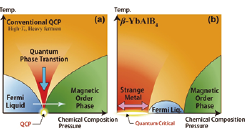Strange Metal Phase without Magnetic Criticality
Nakatsuji and Uwatoko Groups
In condensed matter physics, it is highly important subject to find a novel state of matter. Through many extensive work performed on strongly correlated electron systems including heavy electron metals, high-Tc superconductors and organic conductors, it has been one of the most intriguing and significant possibility that there should be another class of a metallic phase that cannot be described by the standard frame work of metal, namely, Fermi liquid theory. It has been often called as strange metal phase. However, its strong sensitivity to impurity has made it hard to distinguish it from quantum criticality associated with a singular zero temperature point, namely, quantum critical point.

Fig. 1. Conventional quantum critical point and new types of strange metal phase realized in β-YbAlB4
Nakatsuji and Uwatoko groups at ISSP University of Tokyo and a theoretical group at Rutgers University, USA, have studied the pressure effect on heavy fermion system β-YbAlB4 and found the first evidence of a strange metal phase over an extensive region of pressure by suppressing superconductivity. Just as the melting of ice involves a transition from solid to liquid state, strongly correlated materials exhibit transition between magnetic ordered state and a Fermi liquid state. Among the strongly correlated electron systems, the heavy fermion metals often offer the convenient cases where the transition temperature can be easily tuned, for example, by varying a physical parameter, such as magnetic field, external pressure and chemical composition. In particular, the parameter where the transition temperature is suppressed to absolute zero temperature (minus 273.15 °C) is called quantum critical point (QCP). Nearby the quantum critical point, at low temperatures, a strange metal state is believed to emerge due to quantum critical fluctuations associated with the instability between the magnetic ordered state and Fermi liquid state (Fig. 1(a)). As the quantum critical point is very unstable, the quantum critical phenomena such as the non-Fermi liquid state and superconductivity appear only nearby quantum critical point (conventional QCP in Fig. 1).
Here, we show our experimental study on an ultrapure single crystal of the Yb-based heavy fermion compound β-YbAlB4. β-YbAlB4 is known to have a zero magnetic field and zero pressure quantum critical point and exhibits pronounced strange metal state and superconductivity at low temperatures [1-3]. We applied high pressures and performed high resolution measurements of electric resistivity at low temperatures to investigate its electrical properties. A small magnetic field was used to suppress the superconductivity to reveal the strange metal state. Eventually, we succeeded in elucidating a number of surprising phenomena (Fig. 1(b)) [4]:
- In the extensive pressure regime (0 < P < 0.4 GPa), a strange-metal region with non-Fermi liquid properties exists beneath the superconducting dome.
- Both the strange metal phase as well as the superconducting (SC) phase (0 < P < 1 GPa) are isolated from the border of magnetism (P > 2.5 GPa).
- The strange metal phase can not be described by the standard theory of metals based on spin fluctuations. A new type of mechanism is expected, and is most likely associated with valence fluctuations.
These discoveries imply the existence of a strange metallic phase (Fig. 1(b)), which should be well distinguished from the quantum critical states associated with a magnetic quantum critical point (conventional QCP in Fig. 1(a)). This insight may be useful for clarifying the mechanism for the strange metal phase. It may also contribute to understanding the superconducting mechanisms associated with other classes of strongly correlated materials such as Cu-based and Fe-based high-temperature superconductors.
References
- [1] S. Nakatsuji, K. Kuga, Y. Machida, T. Tayama, T. Sakakibara, Y. Karaki, H. Ishimoto, S. Yonezawa, Y. Maeno, E. Pearson, G. G. Lonzarich, L. Balicas, H. Lee, and Z. Fisk, Nature Physics 4, 603 (2008).
- [2] K. Kuga, Y. Karaki, Y. Matsumoto, Y. Machida, and S. Nakatsuji, Phys. Rev. Lett. 101, 137004 (2008).
- [3] Y. Matsumoto, S. Nakatsuji, K. Kuga, Y. Karaki, N. Horie, Y. Shimura, T. Sakakibara, A. H. Nevidomskyy, and P. Coleman, Science 331, 316 (2011).
- [4] T. Tomita, K. Kuga, Y. Uwatoko, P. Coleman, and S. Nakatsuji, Science 349, 506 (2015).
